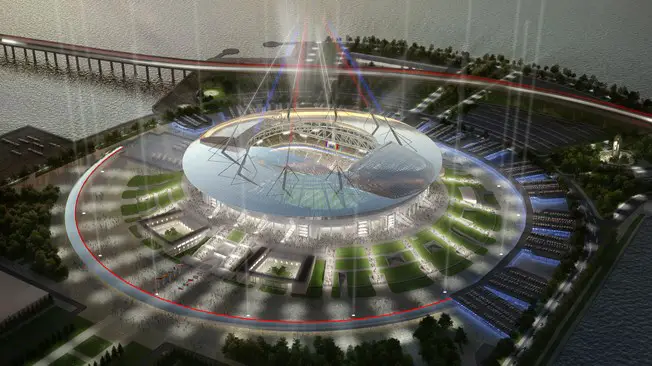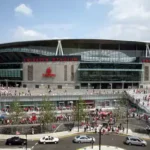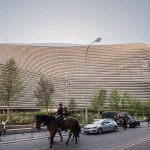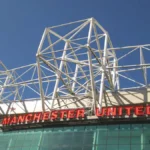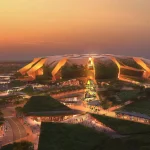2018 World Cup Russia Stadiums, FIFA Arena Buildings, Sports Venues Architecture
Russian World Cup Stadiums
FIFA 2018 Football Venues: Ground capacities, buildings information + images
post updated 26 March 2024
Russian World Cup Stadium Buildings
All 12 Completed stadiums:
Russian World Cup Stadiums 2018 Film on YouTube
28 + 14 Jun 2018
Russia World Cup Stadium Buildings
This stadium design – the only World Cup 2018 venue East of the Urals, is arousing great interest, due to its new seating that pops out of the stadium. The capacity was 27,000, just shy of FIFA’s minimum 30,000 for groups stages. The answer was to build new stands at both ends of the pitch, behind the goals:
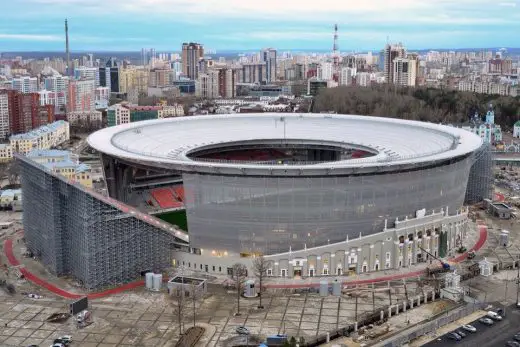
photo By Lobachev27 – Own work, CC BY 4.0, https://commons.wikimedia.org/w/index.php?curid=64451066
Nizhny Novgorod Stadium
45 000 capacity
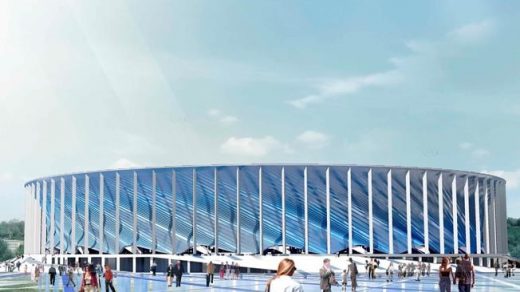
image © LOC
Nizhny Novgorod Stadium’s design is inspired by aspects of nature in the Volga region – water and wind. At the same time, given its location near the city’s most historic districts, the building must have a silhouette that is restrained and severe. Its light basic structure, made up of fine triangular supports arranged in a circle, supports a semi-transparent undulating façade that conceals the bowl of the stadium.
Samara Arena
44 000 capacity
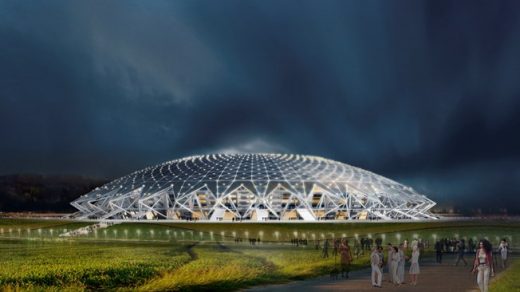
image © LOC
Samara Arena’s design concept is dominated by the theme of space, as a tribute to the traditions of the region, and its renowned aerospace sector. The shape of the stadium will resemble a glass dome. A light, metallic hi-tech basic structure of weight-bearing supports will provide a cover over the stands, which will be 60 metres high. By evening, the whole structure will be lit up, emphasising the stadium’s expressive design.
Volgograd Arena
45 015 capacity
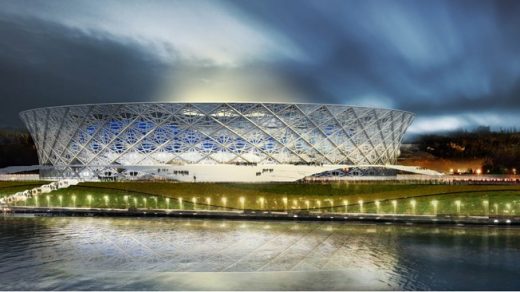
picture © LOC
The stadium’s façade takes the form of an inverted, truncated cone with an open lattice structure, lending the entire building a monumental solidity. The design for the façade supports and the windbreaks embody aspects of a Victory Day firework display. The special way in which the stadium’s roof has been constructed, with cables reminiscent of the spokes of the wheel on a bicycle, lends the arena an extra element of airiness.
Fisht Stadium, Sochi
47 659 capacity
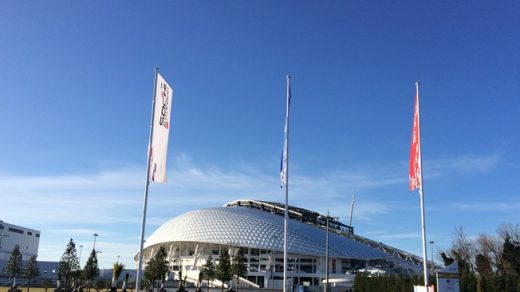
image © LOC
Fisht Stadium was built for the Winter Olympics in February 2014. The ground was originally named after Mount Fisht, a peak in the Caucasus range of mountains. In the local language, Adygeyan, “fisht” means “white head”. The silhouette of the arena, which was designed by British architects, resembles a snow-capped mountain peak.
Dates: 14 June – 15 July 2018
Tournament format: 32 national teams
Russia World Cup Stadiums 2018 on YouTube
Russian World Cup Stadiums
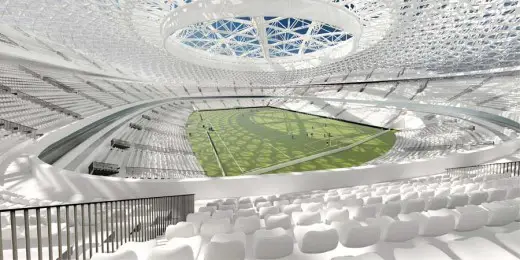
image © (Designed by) Erick van Egeraat
Stadium names for the 2018 FIFA World Cup Russia confirmed
The official names of the stadiums for the 2018 FIFA World Cup are as follows:
∙ Ekaterinburg Arena – Ekaterinburg
∙ Fisht Stadium – Sochi
∙ Kazan Arena – Kazan
∙ Kaliningrad Stadium – Kaliningrad
∙ Luzhniki Stadium; Spartak Stadium – Moscow
∙ Mordovia Arena – Saransk
∙ Nizhny Novgorod Stadium – Nizhny Novgorod
∙ Rostov Arena – Rostov-on-Don
∙ Samara Arena – Samara
∙ Saint Petersburg Stadium – Saint Petersburg
∙ Volgograd Arena – Volgograd
A FIFA delegation visited the building site of a new terminal for Kurumoch airport and a stadium under construction in Samara. Both facilities are being built ahead of the 2018 FIFA World Cup in Russia.
Previously:
In September 2012 the eleven host cities that will organise the 2018 FIFA World Cup tournament in Russia were announced.
The 64 matches will be staged at twelve venues.
Among the host cities are: Moscow, being the only city with two stadiums selected, Saint Petersburg, Kaliningrad, Nizhny Novgorod, Kazan, Samara, Saransk, Volgograd, Rostov-on-Don and Yekaterinburg.
The 2018 FIFA World Cup will be the 21st FIFA World Cup, an international men’s football tournament, that is scheduled to take place between 14 June and 15 July 2018 in Russia.
This will be the first World Cup held in the area of the former Soviet Union.
The finals tournament will involve 32 national teams, including that of the host nation, assuming the current format of the finals is maintained. The final is to take place in Moscow at the Luzhniki Stadium.
World Cup 2018 Stadiums Russia
World Cup 2018 Stadiums under construction
Name, City – Capacity
Luzhniki, Moscow – 81 000
Zenit Arena, St Petersburg – 69 501
Fisht Olympic Stadium, Sochi – 47 659
Kazan Arena, Kazan – 45 105
Otkritie Arena, Moscow – 44 000
Stadion Yubileyniy Saransk, Saransk – 44 000
World Cup 2018 Stadiums designs
Name, City – Capacity
Luzhniki, Moscow – 81 000
Zenit Arena, St Petersburg – 69 501
Fisht Olympic Stadium, Sochi – 47 659
Baltic Arena, Kaliningrad – 45 015
Rotor Arena, Volgograd – 45 015
Kazan Arena, Kazan – 45 000
Stadion w Niżnym Nowogrodzie, Nizhny Novgorod – 45 000
Stadion Szynnika Jarosławl, Yaroslavl – 45 000
Stadion Saturn, Ramenskoe – 44 250
Sinara Arena, Yekaterinburg – 44 130
Stadion w Kaliningradzie, Kaliningrad – 44 015
Stadion Samara, Samara – 44 000
Stadion Yubileyniy Saransk, Saransk – 44 000
Otkritie Arena (Stadion Spartak), Moscow – 44 000
Stadion Rostov, Rostov-on-Don – 43 702
Centralnyj Stadion, Yekaterinburg – 35 000
Russian World Cup Stadiums film on YouTube
Russian World Cup Stadium Buildings
Selected 2018 FIFA World Cup Venues in more detail
Dynamo Stadium – 2018 FIFA World Cup Venue
Architects: (Designed by) Erick van Egeraat
VTB Arena Park – Russian World Cup Stadium (Dynamo Moscow)
Erick van Egeraat’s and Mikhail Posokhin’s VTB Arena to be Russia’s main stage for the 2018 FIFA World Cup™
On the 2nd of December FIFA announced their selection of nations for the 2018 and 2022 FIFA World Cup host at the Zurich Exhibition. In 2018 Russia will be hosting the FIFA World Cup.
Rostov Stadium, Rostov-on-don, Russia
Design: Populous
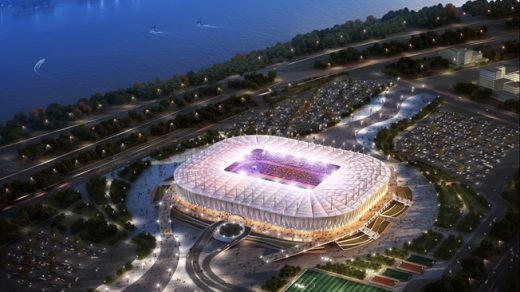
image © LOC
Rostov World Cup Stadium
This will be the fourth stadium that Populous has designed in Russia to be used for the 2018 World Cup, together with Kazan, Saransk, Sochi.
Luzhniki stadium, Moscow
81 000 capacity
Luzhniki Stadium 2018 World Cup
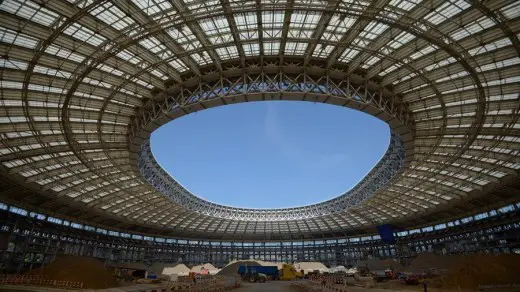
arena image from FIFA
Since Luzhniki Stadium was first opened in 1956, it has hosted a number of international sports events, including the opening and closing ceremonies of the 1980 Olympic Games, the 2008 UEFA Champions League final and the world championships of a variety of sports. The arena will be closed for major renovation work in August 2013, before re-opening five years later to reveal its new image to visitors to Russia 2018.
Zenit Arena, St Petersburg
69 501 capacity
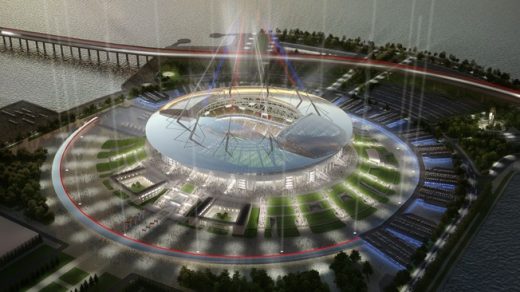
image © LOC
Nizhny Novgorod World Cup Stadium
The stadium on Krestovsky Island promises to be one of the most striking of Russia 2018. The high-tech arena will have a retractable roof and sliding pitch, which ensures that the surface can be maintained in ideal condition at any time of year.
Stadion Nizhny Novgorod, Nizhny Novgorod
45 000 capacity
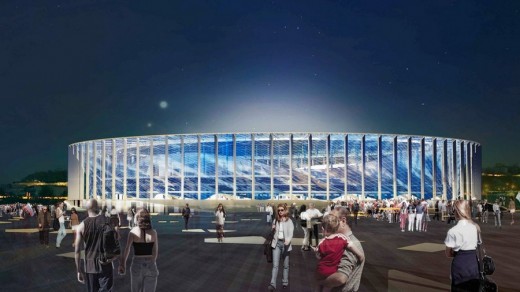
arena picture from FIFA
Nizhny Novgorod World Cup Stadium
According to construction plans devised for the stadium site, the total area will be 37 hectares, 21 of which are allocated to the arena. A new metro station will also be built there, benefiting local residents and those visiting Nizhny Novgorod wanting to see matches at the new stadium. The construction site is currently being cleared, and building will commence in the next few weeks.
Otkritie Arena (Stadion Spartak), Moscow
44 000 capacity
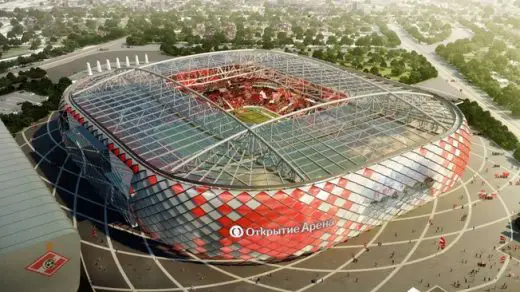
image © LOC
Stadion Spartak World Cup Stadium
The second of 12 stadiums for the 2018 FIFA World Cup Russia™ was inaugurated on Friday in Moscow. One of Russia’s most popular football clubs, Spartak Moscow, at last has a home of its own. The Red-Whites marked the historic event with a grand concert and friendly against Serbian club Red Star Belgrade.
The brand new home for Spartak opened to fans on 5 September and the arena seats 45,000 supporters while complying with all FIFA requirements. The stadium has a bright, unique appearance; the club’s signature red and white colours adorn the arena façade, which is also decorated with ‘combat chainmail’.
Mordovia Arena, Saransk
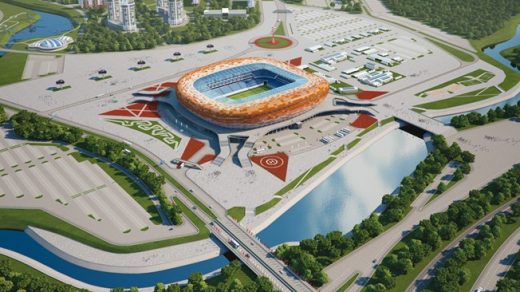
image © LOC
Kaliningrad Stadium
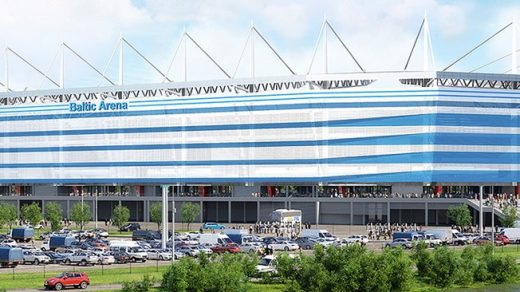
picture © LOC
Kaliningrad Stadium was built for Russia 2018 on Oktyabrsky Island, right in the heart of Kaliningrad. The selection of Kaliningrad as a host city has prompted the local authorities to develop the island, which for many centuries has been a wilderness, left largely untouched. After the 2018 World Cup, a new residential development will be built around the stadium, with parks, quays and embankments alongside the Pregola river.
Ekaterinburg Arena
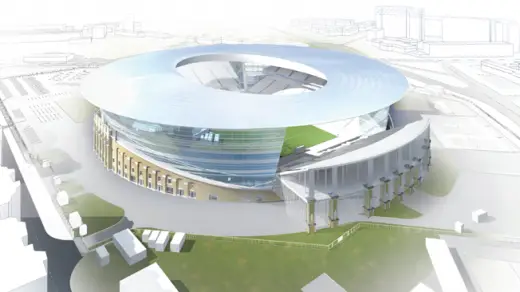
picture © LOC
Home to one of the country’s oldest football clubs, FC Ural, the stadium was built in 1953. Since then, it has been refurbished on a number of occasions. The last of these refits has been made for the 2018 FIFA World Cup™. On each occasion, however, the stadium’s historical façade remained untouched, as an architectural legacy. Architectural and decorative features typical of Soviet neo-Classicism were used lavishly in the construction of the stands, along with decorative art in the form of sculptures, vases and banners.
Kazan Arena
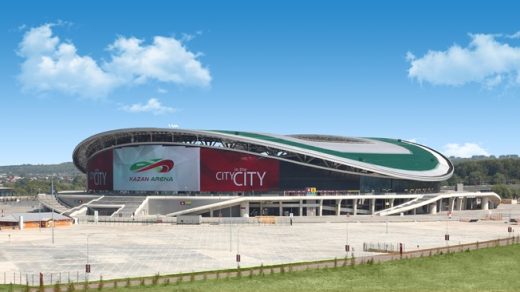
picture © LOC
Kazan Arena was built in preparation for the Summer World University Games in 2013, when it hosted the opening and closing ceremonies. A football pitch was installed once the games were over. The stadium hosted its first match in August 2013, when Rubin Kazan drew 1:1 with Lokomotiv Moscow, and also served as a FIFA Confederations Cup 2017 venue.
Kazan Arena was designed by architects Populous who were involved in the design for Wembley Stadium (designed by Foster + Partners) and Emirates Stadium in London. It has a unique design, which blends seamlessly into Kazan’s urban landscape. Viewed from above, the arena, which stands on the banks of the Kazanka river, resembles a water-lily.
Russian World Cup Groups
Group A Russia, Saudi Arabia, Egypt, Uruguay
Group B Portugal, Spain, Morocco, Iran
Group C France, Australia, Peru, Denmark
Group D Argentina, Iceland, Croatia, Nigeria
Group E Brazil, Switzerland, Costa Rica, Serbia
Group F Germany, Mexico, Sweden, South Korea
Group G Belgium, Panama, Tunisia, England
Group H Poland, Senegal, Colombia, Japan
Russian World Cup Stadiums images / information welcome
Location: Russia
New Architecture in Russia
Contemporary Russian Architecture
Russian Architecture Designs – chronological list
Russia Architecture Walking Tours
Dynamo Stadium, Moscow – 2018 FIFA World Cup Venue
image © (Designed by) Erick van Egeraat
Website: Russia 2018 FIFA World Cup
Comments / photos for the Rostov Stadium – Russian 2018 World Cup Building page welcome
Website: World Cup 2018 Stadiums Russia

